MXA’S 2012 KAWASAKI KX450F MOTOCROSS TEST: AN ENGINE AND A-HALF IN AN IMPROVED PACKAGE
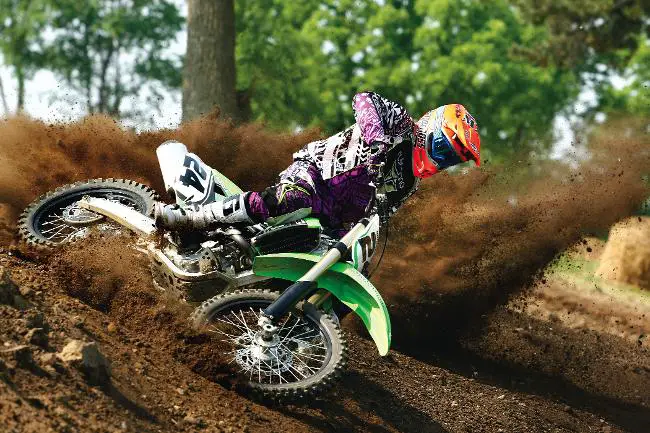
Q: FIRST AND FOREMOST, IS THE 2012 KX450F BETTER THAN THE 2011 KX450F?
A: Yes. Always known as an “engine company,” Kawasaki has finally begun to make some headway on its weak points.
Q: HAS THE KX450F IMPROVED SINCE ITS 2006 INTRODUCTION?
A: The typical answer, regardless of brand, is yes, but often improvements come in bursts and squirts with setbacks between the gains. Here is a brief history of the KX450F from its debut in 2006 to today.
2006 KX450F: The 2006 KX450F was really an offshoot of the failed 2005 KX450. The 2005 model never saw the light of day because of a catastrophic frame failure during testing. As it was, the 2006 was hampered by its four-speed tranny, sedate midrange engine, mediocre suspension, weak brakes and odd handling.
2007 KX450F: Kawasaki made a major effort to fix the flaws of the 2006 model in 2007. Power climbed three horsepower, and the gearbox got a fifth gear (albeit just added on top of the other four). They tried to fix it, but failed with the wallowy rear suspension and cranky handling.
2008 KX450F: In a strange move, Kawasaki gave back most of the three horsepower it gained in 2007. With less bark, the engine became more manageable but not faster. With stiffer valving front and rear, the suspension was improved, but the handling didn’t win any converts.

2009 KX450F: The big news in 2009 was fuel injection. The good news was that they got back the power they gave up in 2008. It was the best fuel-injected powerband up to this point in time?an awesome engine. Considering the new frame, narrower spars, 2-pound weight reduction, 3mm-higher swingarm pivot, 23mm offset (down from 24mm) and all-new rising-rate linkage, you would have expected a big improvement in handling. Didn’t happen.
2010 KX450F: The box-bridge piston stopped piston breakage issues, while a shorter exhaust pipe, stronger clutch and bigger radiators added up to a 2010 engine that was even better than the awesome 2009 powerband. The rest of the package seemed to tread water. The forks were stiffer, and the rear shock got another new rising-rate linkage, but it still wallowed and had a gappy gearbox and spongy brakes.
2011 KX450F: Kawasaki isn’t afraid of making changes. The 2011 model got a new map, longer muffler, flexier motor mounts and a revised shift mechanism. The engine was a little mellower off the bottom, but still great. What didn’t improve were the handling and the suspension?Kawasaki’s traditional bugaboos.
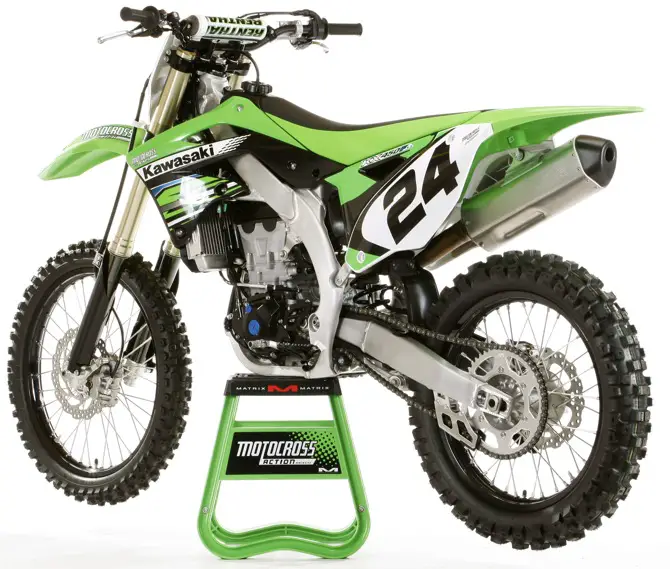
Q: WHAT DID KAWASAKI CHANGE ON THE 2012 KX450F?
A: Now that you know the track record of the Kawasaki KX450F, you can see that it is basically a bike with an incredible engine and powerband that has struggled with its suspension and handling for six long years. So, what did Kawasaki change for 2012? Here is the list:
(1) Cosmetics. With the exception of black rims, new tank decals and subtle bodywork tweaks, the 2012 KX450F looks like the 2011 KX450F. Not true?well, at least not entirely true.
(2) Frame. The 2012 frame spars are 4mm closer together, the fuel tank is smaller (1.6 gallons), and the footpegs are adjustable by 5mm (up or down).
(3) Engine. With a new intake cam, redesigned box-bridge piston, thinner upper ring, stiffer clutch springs, better-designed fuel pump, shorter head pipe and 60mm-shorter muffler, the KX450F engine has been refined more than remade. Plus, the shift mechanism was reworked for the umpteenth time.
(4) Electronics. When you buy a 2012 Kawasaki KX450F, you get two additional plug-in maps (aggressive and mellow). Plus, the Kawasaki KX450F has a push-button-activated “Launch Control” mode that retards the ignition when the bike is in first or second gear. Launch Control tames the power to lessen wheel spin off the line; it returns to the stock map when you shift into third gear.
(5) Transmission. The new gearbox has four dogs instead of three (for better engagement), a shorter shift fork (for a more positive feel), 2.8mm-thicker first gear (for more durability) and a 3mm-longer shift lever (to compensate for the adjustable footpegs).
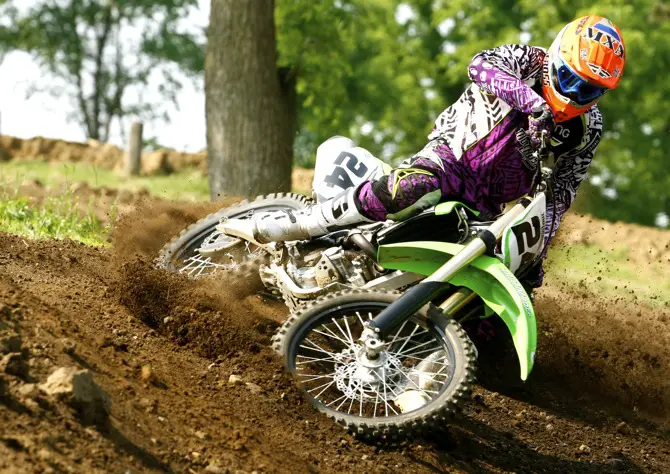
2012 Kawasaki KX450F: Although to the untrained eye it doesn’t look all that different from last year’s KX450F, the 2012 KX450F is, in fact, totally new in most aspects
Q: WHAT SHOULD KAWASAKI CHANGE FOR 2013?
A: It might seem presumptuous of the MXA wrecking crew to tell Kawasaki what to change on their machine, but this could be such a great bike with a few mods.
(1) Weight. Without gas in the tank, the 2012 KX450F hits the MXA scales at 242 pounds. That is 22 pounds heavier than the AMA weight limit.
(2) Brakes. If this bike weighed in at the AMA minimum, maybe?just maybe?these spongy brakes would stop it. But with the 2012 KX450F’s ample horsepower and girth, these brakes are 98-pound weaklings.
(3) Sound. The good news is that the 2012 KX450F passed the AMA’s 94 dB sound test with flying colors at 93.4 dB. The bad news is that the AMA is going to drop its current sound test for the FIM’s two-meter-max test. Tested the FIM way, the KX450F was the loudest bike we have ever tested. It blew 122 dB (at six feet with the throttle wide open for one second).
Q: HOW FAST IS THE 2012 KX450F?
A: We loved the 2008, 2009, 2010 and 2011 KX450F powerbands. These were great engines even though they weren’t always helped by poor gear ratios, balky shifting or weak clutches. We had no doubts that the 2012 engine would be just as good as its brothers. We were wrong; it’s better.
Low-end power is similar to last year, but with more grunt. It isn’t as smooth down low as the 2011 powerband. Instead, it feels more like the more abrupt 2010 model from idle to about 8000 rpm. From 8000 rpm on, the 2012 KX450F romps all of its green predecessors. It is a couple of horses better from 8500 rpm all the way until the rev limiter kicks in at 11,500 rpm.
The new bike is faster, more powerful, more aggressive and downright blissful to ride in loamy dirt.
Q: IS THE 2012 KX450F TOO POWERFUL?
A: There are lots of pit pundits who claim that 450s are too powerful for mortal men, which is where the KTM 350SXF got its impetus. MXA doesn’t believe this. Why not? Because even our slowest test riders hold the KX450F wide open and jump up and down on the seat to get it to go faster at some point during every moto. True, they are as gentle as a newscaster petting a zoo lion when the KX450F is on slippery ground or in tight twisties, but Kawasaki has found a way to make everyone happy (from the kitty cat lovers to the roaring-beast fans).
The 2012 KX450F comes with three maps for the ECU. The three maps are labeled “soft,” “hard” and “stock.” Ignore those names, because they refer to the type of ground, not the type of power. Instead, call them “aggressive” instead of soft, “mellow” instead of hard and stock…well, you get the idea. By changing the maps, which takes about 30 seconds, you can turn the roaring beast into a kitty cat and back again.
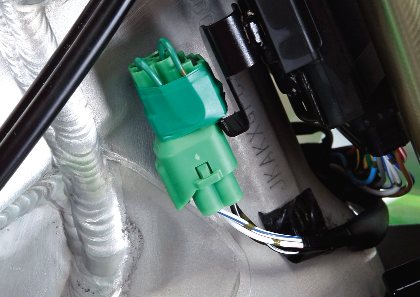
Weapon of choice: It’s a big bike with a big heart. We stiffened the suspension, front and rear, and fiddled with the chassis?but there is little we could do about the 242 pound weight (without gas). And we changed the map plug-in to suit the track we were at.
Q: WHAT DO THE THREE MAPS RUN LIKE?
A: Pick your poison.
Stock map. Half of the MXA test riders preferred the stock map. It hit hard, pulled strongly through the midrange and climbed to a healthy 55.50 horsepower at peak. It worked extremely well with Kawasaki’s poorly conceived gear ratios, because it had the thrust to get over the second-to-third gear gap.
Mellow map. Half of the MXA test riders put the mellow map in and left it there. The mellow map wasn’t as aggressive off the bottom; it didn’t rush through the midrange, but still had decent over-rev. It not only tamped down the throttle response, but it muted the horsepower anywhere from one to two ponies below 9500 rpm (it had no effect above 9500).
Aggressive map. You may have noticed that no MXA test riders elected to run the aggressive map. There were two reasons for this. (1) There is absolutely no horsepower difference at any point on the KX450F powerband between the stock map and the aggressive map. Without any numerical advantage, most test riders opted for the more manageable power delivery of the stock map over the snappier aggressive map. (2) If the two maps produce the exact same horsepower and torque, what is the difference? Feel. The “aggressive” map feels more aggressive. The power hits harder in the low-end. On hard dirt, the rear wheel steps out more, and the bike tends to feel jumpy coming out of ruts. It should be noted that on sand tracks or in deep loam, the difference between the stock and aggressive maps was almost imperceptible.
Q: IS LAUNCH CONTROL A GOOD IDEA?
A: Yes. Launch Control retards the ignition when the bike is in first or second gear (after the button has been pushed and while the light is flashing). How much does it retard the ignition? At 7000 rpm, the KX450F makes 44.23 horsepower with or without Launch Control activated. At 8000 rpm, the KX450F makes 1-1/2 horsepower less with Launch Control engaged. At 9000 rpm, Launch Control loses over two horsepower to the stock map. At 10,000 rpm, Launch Control mellows out the power pulses by 2-1/2 horsepower. At 11,000 rpm, the Launch Control-activated bike makes four horsepower less.
On concrete starts, MXA test riders used Launch Control every time and loved it. On long loamy starts, they felt that it gave up too much ground at high rpm?and didn’t use it. On starts of various lengths, they chose Launch Control based on the texture of the dirt. Soft dirt, no Launch Control; hard dirt, Launch Control.
Launch Control is not a byproduct of fuel injection. It could have been invented and used since the development of digital ignitions 20 years ago?and maybe it has been used on works bikes for that long?but Kawasaki is the first to put it on a production bike.
Q: HOW DOES IT RUN ON THE DYNO?
A: It makes 55.50 horsepower at peak (the 2011 KX450F made 54.17). Best of all, it crested the 50-horsepower mark at 7400 rpm and stayed above that mark all the way to 10,200 rpm. That is an awesome spread of power. It makes more horsepower than the 2011 KX450F engine from 6200 rpm all the way to sign-off, but doesn’t really whip the 2011 KX450F bad until 8500 rpm?and by 9500 it is making three horsepower more.
Q: HOW DOES THE 2012 KX450F HANDLE?
A: Kawasaki plugged away at fixing its odd handling bikes for six years?and, we hate to say it, but they made very little headway. No matter what changes they made to the head angle, offset, frame rigidity or layout, the KX450F always stood up in the center of turns. It refused to lean over without a berm, and if given even a little leeway, it would rise up in a herky-jerky motion.
For the first time in its seven-year history, Kawasaki has managed to tame the chassis. They claim that it was a combination of centralization of mass, a narrower frame, more resilient motor mounts, reduced spar ribbing and a stiffer swingarm pivot. We will take them at their word, because there are no geometry, offset or weight changes that could take the credit.
Whatever caused the transformation, this is the best-handling KX450F of the bunch. It doesn’t stand up in the center of the corners. It tracks accurately and doesn’t wander off line like its predecessors did.
It isn’t perfect?and it will never be perfect as long as it feels like an overstuffed living room sofa at speed.
It needs to go on a diet and get a steeper head angle, shorter wheelbase, lower seat height, smaller overall size, better ergonomic riding position and less fork offset. Maybe next year.
Q: WHAT WAS OUR BEST FORK SETTING?
A: Kawasaki stuck with Kayaba AOSS forks long after every other brand had given up on them and moved to greener pastures. We don’t like the way these forks feel in the second half of the stroke. They are harsh. We opted for stiffer springs and a lower oil height to smooth out the middle of the stroke.
For hardcore racing, these are MXA’s recommended 2012 Kawasaki KX450F fork settings (stock settings are in parentheses):
Spring rate: 0.50 kg/mm (0.48 kg/mm)
Oil height: 320cc (335cc)
Compression: 14 clicks out (10 clicks out)
Rebound: 12 clicks out (10 clicks out)
Fork leg height: 10mm up
Notes: The chassis is very sensitive to fork height. As a rule, we ran the forks up in the clamps until we got oversteer, then slid them down 2mm. On some tracks, the forks were 12mm up in the clamps.
Q: WHAT WAS OUR BEST SHOCK SETTING?
A: Two years ago, the 2010 KX450F got an all-new bell crank and link arm mated to a stiffer 5.5 kg/mm shock spring. For 2011, the linkage and spring stayed the same. The 2012 KX450F gets new pullrods, but they aren’t longer or shorter?only thinner in profile. We opted to go stiffer on the shock spring to lessen the dead feel on the stock shock. If you are under 175 pounds, the stock shock spring will probably work well. Use free sag as your gauge.
For hardcore racing, these are MXA’s recommended 2012 KX450F shock settings (for the stock setup):
Spring rate: 5.8 kg/mm (5.5 kg/mm)
Race sag: 100mm
Hi-compression: 2 turns out (1-1/2 turns out)
Lo-compression: 10 clicks out
Rebound: 14 clicks out (16 clicks out)
Notes: We run a 136mm Pro Circuit shock linkage in place of the stock 135mm KX450F link. It lowers the seat height, rotates the bell crank deeper into its curve before the shock starts to move and makes the compression damping a little firmer initially.
Q: WHAT IS THE SUGGESTED RETAIL?
A: The manufacturer’s suggested retail price (MSRP) is $8149 ($250 more than last year).
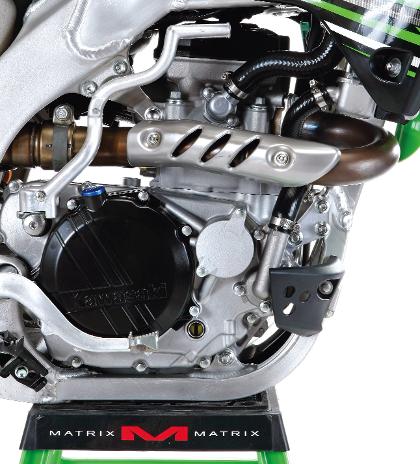
Da champ: Kawasaki has built the greatest Open class engines for the last four years. It boasts 55.50 horsepower (up from 54.17 horsepower last year). The 2012 is a chip off the old block.
Q: WHAT DID WE HATE?
A: The hate list:
(1) Brakes. The sensation of stopping is not followed by any actual stopping. The 250mm rotor, dual piston and non-floating front brake should work better than this.
(2) Weight. It’s too big, too tall and too heavy.
(3) Rear brake pedal. If you want to run the rear brake pedal low, you have to hacksaw off some of the plunger’s threaded rod.
(4) Front tire. We never liked 90-width front tires and are glad to see that Kawasaki finally stopped spec’ing the 90s in favor of the better-turning 80/100-21 front tire.
(5) Chain guide/buffer pad. What chain guide? Put TM Designworks on your speed dial.
(6) Plastic. In the past, Kawasaki plastic has cracked and splintered like a balsa wood freight train. The 2012 plastic seems to be a little sturdier, but it gets white streaks in it from every rock ping.
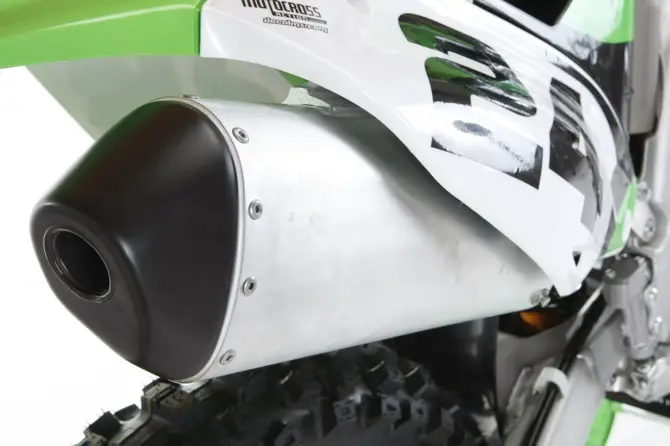
(7) Sound. To pass the AMA sound test, Kawasaki uses a tapered perf core inside the muffler?and doesn’t perforate the last 5 inches of it. This odd configuration makes the KX450F pass the AMA test. Unfortunately, it is just a trick and doesn’t quiet the bike one iota at full speed. It failed the FIM’s 115 dB two-meter-max test with an ear-piercing 122 dB.
(8) Fuel capacity. We weren’t all that happy with 1.98 gallons of gas. The 2012 KX450F only carries 1.64 gallons. This is not a GNCC, WORCS, GP or trail-riding amount of fuel.
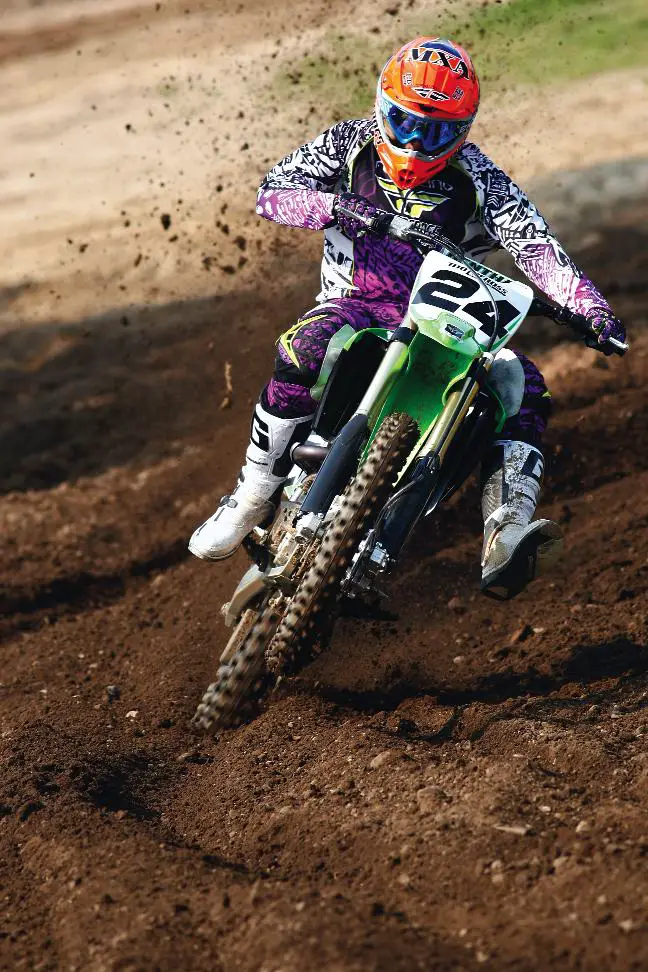
Q: WHAT DID WE LIKE?
A: The like list:
(1) Adjustable footpegs. The 50mm-wide Kawasaki footpegs can be moved up or down over a 5mm range. This is a cool idea. Every test rider put them in the up position and left them there.
(2) Graphics. Tracks across America have been littered with KX450F graphics since 2006. Thankfully, the 2012 graphics stayed put for a reasonable amount of time.
(3) Tires. We love Bridgestone 403/404 tires.
(4) Adjustable power. You gotta love a bike that comes with a plethora of different powerbands?that can be changed in 30 seconds.
(5) DLC. We don’t like the AOSS forks all that much, but we love the Diamond Like Coating (DLC) on the fork legs and Kashima coating on the inner surfaces of the stanchion tubes.
(6) Ergos. Overall, we feel that the KX450F is too bulky, but every test rider noticed the narrower frame and gas tank.
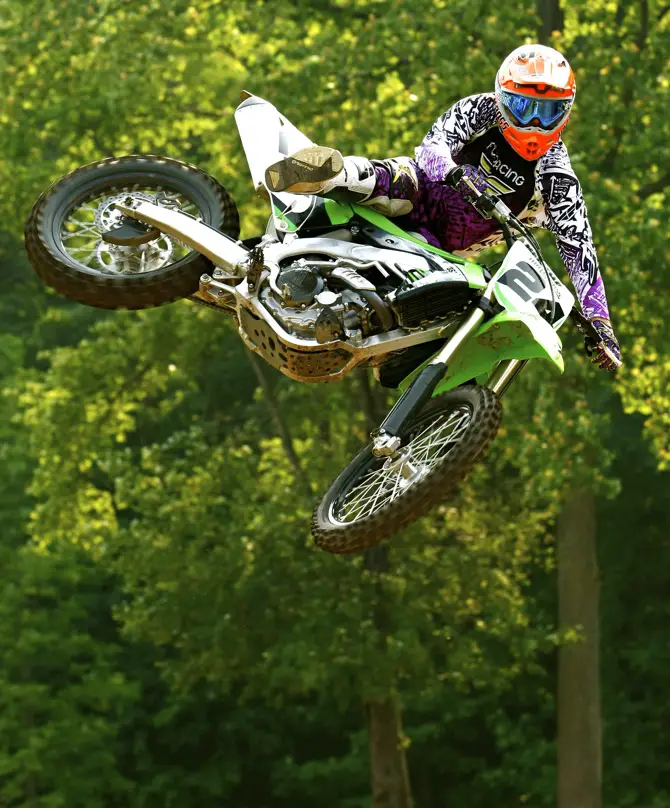
Q: WHAT DO WE REALLY THINK?
A: This bike is defined by its engine. The 2012 KX450F powerband, with or without its electronic aids, is marvelous. You’ll never need to hop this engine up, which is good, because you’ll need that dough to fix some of the Kawasaki’s other eccentric peccadilloes.






Comments are closed.